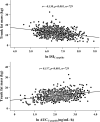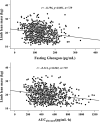Connections between body composition and dysregulation of islet α- and β-cells in type 2 diabetes
- PMID: 38191505
- PMCID: PMC10775650
- DOI: 10.1186/s13098-023-01250-3
Connections between body composition and dysregulation of islet α- and β-cells in type 2 diabetes
Abstract
Background: Accompanying islet α- and β-cell dysregulation in type 2 diabetes (T2D) at the microscopic scale, alterations in body composition at the macroscopic scale may affect the pathogenesis of T2D. However, the connections between body composition and islet α-cell and β-cell functions in T2D have not been thoroughly explored.
Methods: For this cross-sectional study, we recruited a total of 729 Chinese Han patients with T2D in a consecutive manner. Dual-energy X-ray absorptiometry (DXA) was used to measure body composition, which included total bone-free mass, total fat and lean mass, trunk fat and lean mass and limb fat and lean mass. Every patient underwent an oral glucose tolerance test to simultaneously detect glucose, C-peptide and glucagon. The indices of islet α-cell function included fasting glucagon levels and the area under the curve of glucagon after a challenge (AUCglucagon), while the indices of β-cell function included the insulin sensitivity index derived from C-peptide (ISIC-peptide) and the area under the curve of C-peptide after a challenge (AUCC-peptide).
Results: Among all patients, fat mass, especially trunk fat mass, was significantly correlated with ISIC-peptide and AUCC-peptide levels (r = - 0.330 and 0.317, respectively, p < 0.001), while lean mass, especially limb lean mass, was significantly correlated with fasting glucagon and AUCglucagon levels (r = - 0.196 and - 0.214, respectively, p < 0.001). Moreover, after adjusting for other relevant variables via multivariate linear regression analysis, increased trunk fat mass was independently associated with decreased ISIC-peptide (β = - 0.247, t = - 3.628, p < 0.001, partial R2 = 10.9%) and increased AUCC-peptide (β = 0.229, t = 3.581, p < 0.001, partial R2 = 8.2%), while decreased limb lean mass was independently associated with increased fasting glucagon (β = - 0.226, t = - 2.127, p = 0.034, partial R2 = 3.8%) and increased AUCglucagon (β = - 0.218, t = - 2.050, p = 0.041, partial R2 = 2.3%). Additionally, when separate analyses were performed with the same concept for both sexes, we found that increased trunk fat mass was still independently associated with decreased ISIC-peptide and increased AUCC-peptide, while decreased limb lean mass was still independently associated with increased fasting glucagon and AUCglucagon.
Conclusions: Increased trunk fat mass may partly account for decreased insulin sensitivity and increased insulin secretion, while decreased limb lean mass may be connected to increased fasting glucagon and postprandial glucagon secretion.
Keywords: Body composition; C-peptide; Glucagon; Type 2 diabetes.
© 2024. The Author(s).
Conflict of interest statement
The authors declare that they have no competing interests.
Figures
Similar articles
-
Fasting serum total bile acid levels are associated with insulin sensitivity, islet β-cell function and glucagon levels in response to glucose challenge in patients with type 2 diabetes.Endocr J. 2020 Nov 28;67(11):1107-1117. doi: 10.1507/endocrj.EJ20-0201. Epub 2020 Jul 17. Endocr J. 2020. PMID: 32684527
-
Serum fatty acid-binding protein 4 levels and responses of pancreatic islet β-cells and α-cells in patients with type 2 diabetes.Diabetol Metab Syndr. 2021 Jun 26;13(1):70. doi: 10.1186/s13098-021-00690-z. Diabetol Metab Syndr. 2021. PMID: 34174950 Free PMC article.
-
Increased serum cystatin C levels and responses of pancreatic α- and β-cells in type 2 diabetes.Endocr Connect. 2022 Mar 21;11(3):e210597. doi: 10.1530/EC-21-0597. Endocr Connect. 2022. PMID: 35179515 Free PMC article.
-
Gender Differences in Relation to Body Composition, Insulin Resistance, and Islet Beta Cell Function in Newly Diagnosed Diabetic or Pre-Diabetic Patients.Diabetes Metab Syndr Obes. 2023 Mar 10;16:723-732. doi: 10.2147/DMSO.S397528. eCollection 2023. Diabetes Metab Syndr Obes. 2023. PMID: 36925991 Free PMC article.
-
Inhibition of glucagon secretion.Adv Pharmacol. 2005;52:151-71. doi: 10.1016/S1054-3589(05)52008-8. Adv Pharmacol. 2005. PMID: 16492545 Review.
References
Grants and funding
LinkOut - more resources
Full Text Sources



